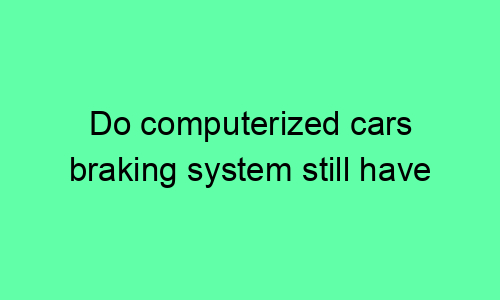## Do Computerized Cars Braking Systems Still Have Mechanical Brakes?
### Introduction
Modern cars are increasingly reliant on computerized systems for various functions, including braking. While these systems offer enhanced safety and efficiency, they have raised concerns about whether they completely eliminate the need for mechanical brakes. This article will delve into the topic, exploring the prevalence of mechanical brakes in computerized cars, their role in ensuring safety, and the advantages and limitations of both systems.
### Mechanical Brakes: A Safety Redundancy
Despite the advancements in computerized braking systems, mechanical brakes remain an integral component in most modern cars. These traditional brakes utilize hydraulic pressure to actuate calipers that clamp down on brake pads, creating friction to slow down or stop the vehicle.
The primary reason for retaining mechanical brakes is safety. Computerized systems, while highly sophisticated, are still susceptible to electronic failures or disruptions. In the event of a system malfunction, mechanical brakes provide a physical backup, ensuring that the driver maintains control over the vehicle’s braking.
### The Role of Computerized Systems
Computerized braking systems, often referred to as electronic brake-force distribution (EBD) or anti-lock brake systems (ABS), enhance the braking performance and safety of vehicles. These systems monitor wheel speed, vehicle speed, and other parameters to optimize brake force distribution and prevent wheels from locking during emergency braking.
EBD adjusts the brake pressure applied to each wheel, maximizing stopping power while maintaining stability. ABS prevents wheels from locking, allowing the driver to maintain steering control during hard braking maneuvers. By reducing skidding and optimizing brake performance, computerized systems significantly improve safety, especially in wet or slippery conditions.
### Advantages and Limitations of Computerized Brakes
**Advantages of computerized braking systems:**
– **Enhanced safety:** ABS and EBD increase braking efficiency and stability, reducing the risk of accidents.
– **Improved performance:** Computerized systems optimize brake force distribution, resulting in shorter stopping distances and better control.
– **Reduced maintenance:** Computerized brakes do not require frequent adjustments or maintenance like mechanical brakes.
**Limitations of computerized braking systems:**
– **Complexity:** Computerized systems are highly complex and require specialized knowledge for troubleshooting and repairs.
– **Cost:** Advanced computerized braking systems can be expensive to install and maintain.
– **Reliance on electronics:** The functionality of these systems is dependent on electronic sensors and components, which can be susceptible to failures.
### Integration of Mechanical and Computerized Brakes
In most modern cars, mechanical brakes and computerized systems work in conjunction to provide a comprehensive braking solution. Computerized systems enhance the performance and safety of braking, while mechanical brakes serve as a safety net in the event of electronic failures.
### Conclusion
Computerized cars braking systems still incorporate mechanical brakes as a safety redundancy. Mechanical brakes provide a physical backup in case of electronic system malfunctions, ensuring that the driver retains control over the vehicle’s braking. While computerized systems enhance braking performance and safety, they are susceptible to electronic failures. The integration of both mechanical and computerized brakes provides a comprehensive solution that optimizes safety and reliability.






